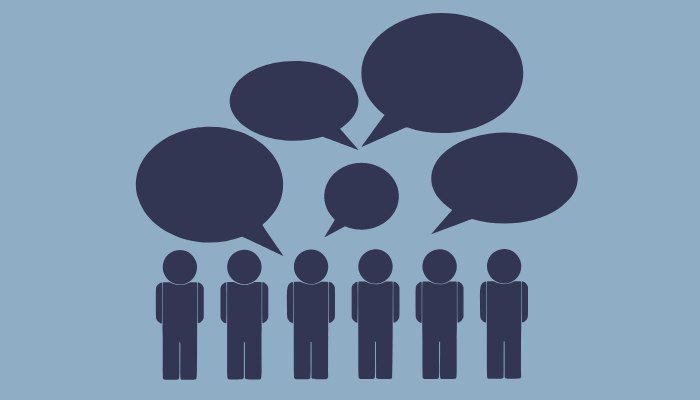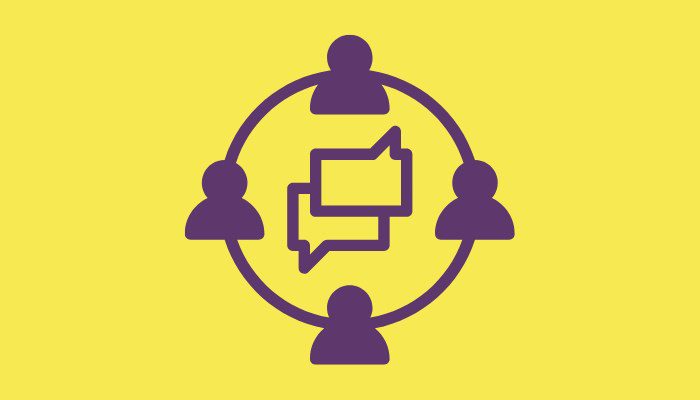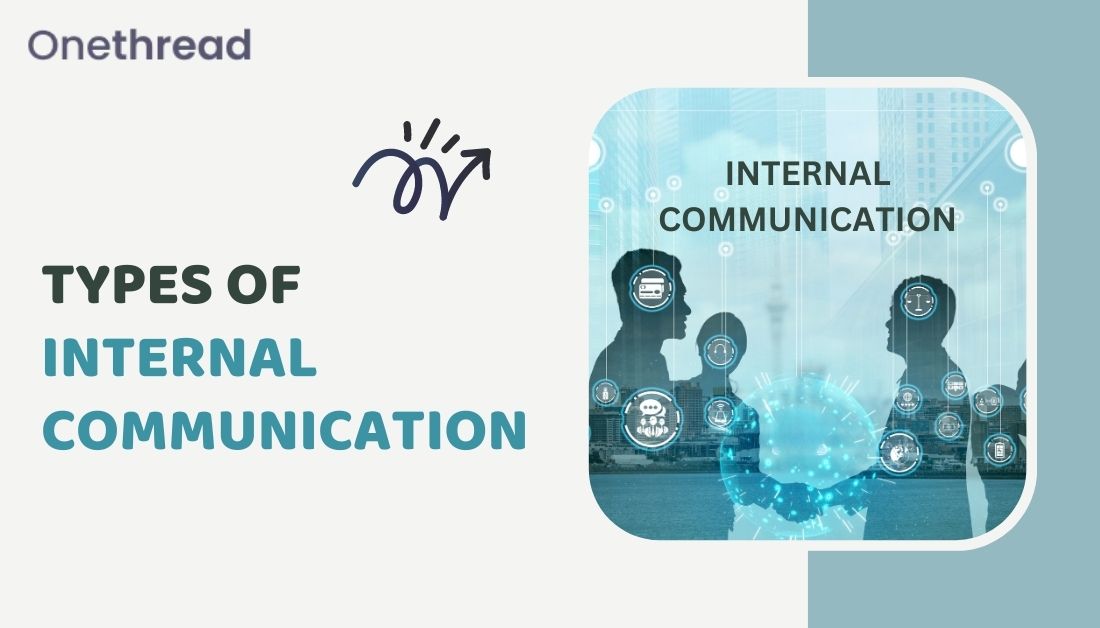In today’s fast-paced business world, effective internal communication is crucial for success. It helps organizations thrive and enhances employees’ lives in meaningful ways.
As Paul Barton rightly stated, “Effective internal communication is a powerful force.” It is a vital aspect that organizations should consider.
This article will delve into internal communication and explore the six types of communication within organizations. From formal to informal channels, each type plays a crucial role in fostering collaboration, disseminating information, and building a cohesive work environment.
Whether you’re a team leader, manager, or an employee looking to enhance your communication skills, this guide will provide valuable insights and practical tips to ace each type of internal communication like a pro. So, let’s dive in and uncover the secrets to mastering internal communication in the workplace.
Internal communication: what is it?
Internal communication refers to exchanging information, messages, and ideas within an organization or company. It is the process of sharing information, updates, and directives among employees at various levels and across different departments or teams within the organization.

The communication of internally is crucial in fostering collaboration, aligning employees with organizational goals, promoting transparency, and building a sense of belonging and engagement among the workforce.
Internal communication can take various forms, including face-to-face interactions, meetings, emails, memos, newsletters, intranet platforms, internal social networks, and other digital communication tools.
It aims to facilitate the flow of information and ensure that employees learn the required knowledge to perform their jobs effectively.
It also helps convey the organization’s vision, values, and strategic objectives, as well as fosters a positive organizational culture.
Effective internal communication involves disseminating information from management to employees and encouraging feedback and two-way communication. It allows employees to share their ideas, concerns, and suggestions, fostering a culture of openness and collaboration.
This two-way communication is vital for employee engagement, motivation, and overall organizational success.
Internal communication strategies can vary from one organization to another, depending on factors such as company size, structure, culture, and industry. However, the primary goal is to ensure that information flows smoothly, accurately, and on time to all relevant stakeholders within the organization.
What Are the Different Forms of Internal Communication?
Every organization has unique needs, and as a result, internal communication methods can vary. Here is a compilation of various internal communication approaches commonly employed by successful businesses today. By delving into each one, you can explore the methods that align with your organization’s goals and implement them effectively.
- Management to Employee Communication
- Change Communication
- Team Communication
- Employee Up Communication
- Crisis Communication
- Project Communication
- Training and Development Communication
- Recognition and Appreciation Communication
To better understand each type, let’s delve deeper into them. This exploration will help you identify the internal communication approaches that resonate with your organization and are worth considering for implementation.
Management to Employee Communication
Management-to-employee communication, or top-down communication, refers to the flow of information from managers or leaders to employees within an organization. It is a formal communication channel where the management team conveys essential messages, updates, directives, and organizational decisions to the employees.

In top-down communication, managers or leaders serve as the primary source of information, guiding and informing employees about the company’s vision, goals, strategies, policies, and other pertinent information.
Adequate top-down communication fosters transparency, trust, and engagement within the organization. It helps employees understand their roles and how their work contributes to the company’s overall success.
How to be a Pro at it?
- Clear and Concise Messaging: Ensure that communication from management is clear, concise, and easily understandable by employees. Use simple language, avoid jargon, and focus on delivering key messages effectively.
- Timely and Regular Updates: Provide timely and regular updates to keep employees informed about crucial organizational news, changes, and initiatives. Establish a communication schedule or cadence to maintain consistency and avoid leaving employees in the dark.
- Use Multiple Communication Channels: Utilize various communication channels, such as emails, memos, team meetings, intranet platforms, or digital collaboration tools, to reach employees effectively. Different channels cater to different preferences and help ensure widespread message dissemination.
Using an internal communication tool such as OneThread can significantly enhance your ability to manage communication across the entire company and within teams effectively.
- Two-Way Communication: Encourage employee feedback, questions, and suggestions to foster two-way communication. Create opportunities for dialogue, such as Q&A sessions, feedback surveys, or dedicated communication channels, to promote an open and inclusive communication culture.
Change Communication
Change communication involves strategically communicating with employees during organizational change, such as restructuring, mergers, process improvements, new technologies, or shifts in organizational culture. Its main goal is to ensure employees understand the reasons for the change, the desired outcomes, and their role in the process.

This communication aims to manage expectations, address concerns, and promote employee engagement and support. Establishing clear and transparent communication channels, including regular updates, town hall meetings, workshops, or digital platforms, is essential to foster open dialogue between management and employees.
How to be a Pro at it?
- Clear and Compelling Messaging: Develop a clear and concise message that outlines the reasons for the change, the benefits of the change, and how it aligns with the organization’s goals. Tailor the message to different employee groups, focusing on their roles’ specific impact and relevance.
- Engage Leadership: Leaders play a crucial role in changing communication. They must be visible, accessible, and actively involved in communicating the change. Employees are more likely to embrace and support the change by showcasing leadership support and commitment.
- Two-Way Communication: Encourage open communication and allow employees to express their concerns, ask questions, and share feedback. Actively listen to employee perspectives and address their questions and concerns promptly and transparently.
- Provide Training and Necessary Resources: Support employees during the change by providing the necessary training, resources, and guidance to help them adjust to the new procedures or systems. Offering comprehensive training programs and clear documentation ensures employees have the knowledge and skills to navigate the change successfully.
Team Communication
Team communication refers to exchanging information, ideas, and feedback among members of an organization’s specific team or project group. It is vital in facilitating collaboration, coordination, and achieving shared objectives within the team.

Effective team communication involves formal and informal channels that enable team members to stay connected, informed, and aligned. It encompasses various communication activities, including meetings, discussions, updates, task assignments, and problem-solving sessions.
How to be a Pro at it?
- Information Sharing: Team communication ensures that team members have access to relevant and up-to-date information related to the project or tasks at hand. This includes sharing project goals, timelines, deliverables, and any changes or updates that impact the team’s work.
- Collaboration and Coordination: Team communication fosters collaboration and coordination among team members, allowing them to work together towards common objectives. It involves exchanging ideas, brainstorming, and discussing potential solutions or approaches to challenges.
- Task Assignment and Progress Updates: Team communication facilitates the distribution of tasks among team members and keeps everyone informed about progress and deadlines. Regular updates ensure that team members know the status of individual tasks and can adjust their work accordingly.
- Problem-Solving and Decision-Making: Effective team communication enables problem-solving and decision-making within the team. It encourages open discussion, active listening, and the exploration of different perspectives to arrive at well-informed decisions.
Employee Up Communication
Employee Up Communication, or upward communication, refers to the flow of information, ideas, feedback, and suggestions from employees to managers or higher-level individuals within an organization. It empowers employees to express their thoughts, concerns, opinions, and recommendations, creating a channel for their voices to be heard and considered.

By embracing Employee Up Communication, organizations can tap into their employees’ valuable insights, perspectives, and ideas.
How to be a Pro at it?
- Feedback and Suggestions: Employee Up Communication encourages employees to provide feedback on various aspects of their work environment, such as processes, policies, procedures, and initiatives.
- Concerns and Issues: It allows employees to raise concerns, express their challenges, or address any issues affecting their work. This communication allows employees to seek clarification, share obstacles they encounter, or highlight areas that require attention from management.
- Professional Development: Employee Up Communication can involve discussions about career growth, skill development, training needs, or opportunities for advancement. Employees can express their aspirations, seek guidance on career paths, or request support for professional development initiatives.
- Performance Feedback: This form of communication enables employees to share their performance accomplishments, seek performance-related guidance, or discuss any challenges they may face.
- Recognition and Appreciation: Employee Up Communication allows employees to share their recognition and appreciation for colleagues, teams, or managers who have positively impacted them. By providing feedback on outstanding contributions, employees can express gratitude and acknowledge the efforts of their peers.
- Employee Engagement: Organizations promote employee engagement and involvement by encouraging Employee Up Communication. When employees feel their opinions are valued and their voices are heard, they are more committed, motivated, and satisfied.
Crisis Communication
Crisis communication refers to the strategic process of communicating with stakeholders during times of unexpected and potentially damaging events or crises that can significantly impact an organization’s reputation, operations, or public perception.

It involves proactive and reactive efforts to effectively manage and control the flow of information, mitigate negative consequences, and maintain trust and credibility.
How to be a pro at It?
- Preparedness: Organizations need a crisis communication plan with defined roles, responsibilities, channels, and protocols for handling crises. This includes anticipating potential crises, conducting risk assessments, and developing strategies for different scenarios.
- Timely and Accurate Information: Providing timely and accurate information during a crisis is crucial. Organizations should swiftly assess the situation, gather facts, and promptly communicate updates to stakeholders. Accuracy prevents misinformation and maintains organizational credibility.
- Stakeholder Engagement: Effective crisis communication involves engaging stakeholders to address concerns, provide reassurance, and answer questions. This includes employees, customers, media, regulators, investors, and the public.
Two-way communication allows organizations to listen, gather feedback, and adapt their response accordingly.
- Media Relations: Managing media relations is vital during a crisis. Designating a spokesperson to handle media inquiries and deliver consistent messages is essential.
This includes preparing press releases, organizing media briefings, and aligning media interactions with the communication strategy.
- Learning and Evaluation: Organizations should comprehensively evaluate their crisis communication efforts after a crisis. This involves analyzing successes, identifying areas for improvement, and updating crisis communication plans accordingly. Learning from the experience enhances future crisis preparedness and response.
Project Communication
Project communication refers to the exchange of information, ideas, updates, and feedback among project team members, stakeholders, and relevant parties throughout the lifecycle of a project. It encompasses all the communication activities necessary to ensure effective collaboration, coordination, and successful project outcomes.

How to be a pro at It?
- Progress Updates and Reporting: Regular project status updates and reporting are essential for keeping stakeholders informed about the progress, milestones, and challenges or risks encountered in the project. These updates include status meetings, progress reports, or digital platforms where project information is shared.
- Issue Resolution and Risk Management: Project communication provides a platform for identifying and addressing project issues, risks, and conflicts. It allows team members to raise concerns, propose solutions, and collaborate on resolving challenges that may arise during project execution. Effective communication helps mitigate risks and ensures timely resolution of issues.
- Change Management: Communication is crucial in managing changes within a project. It involves effectively communicating any modifications to project scope, requirements, or timelines, ensuring that all stakeholders know and understand the impact of those changes. Clear communication helps manage expectations and minimize resistance to change.
- Lessons Learned and Project Closure: Project communication extends to the post-project phase, where teams reflect on lessons learned and share insights for future projects. Communication at project closure involves acknowledging achievements, recognizing team members’ contributions, and capturing valuable knowledge and best practices for future endeavors.
Training and Development Communication
Training and development communication refers to the communication processes and strategies used to facilitate learning, skill development, and professional growth within an organization. It involves exchanging information, instructions, feedback, and resources between trainers, learners, and relevant stakeholders to ensure practical training and development initiatives.

How to be a pro at it?
- Training Needs Assessment: Communication is crucial for identifying training needs within an organization. Surveys, interviews, and performance evaluations gather information about skills gaps, training requirements, and individual or team development needs.
- Training Program Promotion: Effective communication is essential to promote training programs and create employee awareness. Information about the training initiatives’ objectives, content, benefits, and logistics is disseminated through channels like emails, intranets, newsletters, and posters to generate interest and encourage participation.
- Training Scheduling and Logistics: Communication provides learners with detailed information about training schedules, locations, materials, and any prerequisites or preparations required. Clear and timely communication ensures participants are well-informed and prepared for the training sessions.
- Instruction and Delivery: Communication is employed during training sessions to deliver instructions, explanations, demonstrations, and presentations. Trainers use verbal and non-verbal techniques to convey information, engage learners, and facilitate understanding effectively.
- Learner Engagement and Interaction: Communication is vital in engaging learners and encouraging active participation. Opportunities for asking questions, sharing experiences, and participating in group discussions or activities are created. Two-way communication ensures learners are actively involved and can clarify doubts or concerns.
- Post-Training Support: Communication continues after the training program to support learners in applying their newly acquired knowledge and skills. Follow-up resources, job aids, and communication channels allow learners to seek guidance, share challenges, and receive ongoing support.
Recognition and appreciation communication
Recognition and appreciation communication refers to acknowledging and expressing gratitude towards individuals or teams for their exceptional performance. The achievements, or contributions are within an organization.

It involves the exchange of positive messages, feedback, and rewards to recognize and appreciate the efforts and accomplishments of employees.
How to be a pro at it?
- Acknowledgment of Achievements: Communication plays a vital role in acknowledging and highlighting the achievements of individuals or teams. It involves recognizing their hard work, dedication, and outstanding performance in specific projects, tasks, or milestones.
- Public and Private Recognition: Recognition and appreciation can be communicated publicly or privately, depending on the situation and individual preferences. Public recognition can be through team meetings, company-wide announcements, newsletters, or recognition events. While private recognition can involve one-on-one conversations, personalized emails, or handwritten notes.
- Peer-to-Peer Recognition: In addition to recognition from managers or leaders, communication facilitates peer-to-peer recognition. It involves encouraging team members to acknowledge and appreciate the efforts of their colleagues, fostering a positive and supportive work environment.
- Ongoing Recognition Culture: Recognition and appreciation communication help foster an appreciative culture within the organization. It involves regular and consistent communication to reinforce the importance of recognizing and appreciating individuals’ or teams. It contributions, creating a positive work environment, and boosting employee engagement.
Enhancing Internal Communication with OneThread
OneThread is a powerful internal communication tool that can greatly enhance the effectiveness of the various types of internal communication mentioned above. Here’s how Onethread can help improve internal communication:
- Streamlined and Centralized Communication: Onethread simplifies internal communication by bringing all channels together in one place.
- Real-Time Updates and Notifications: Onethread ensures that employees receive timely information and updates instantly.
- Two-Way Communication: Onethread promotes open dialogue and collaboration by facilitating feedback, questions, and idea sharing.
- Document and File Sharing: Onethread enables easy sharing and distribution of essential documents and files.
- Analytics and Insights: Onethread provides valuable data to evaluate communication patterns and effectiveness.
- Mobile Accessibility: Onethread allows employees to stay connected and engaged on the go through mobile accessibility.
Overall, Onethread empowers organizations to streamline, enhance, and optimize their internal communication efforts. However, its leading to improved collaboration, engagement, and overall organizational success.
Conclusion
Implementing effective and efficient internal communication is critical. However, its ensuring that everyone in the organization is focused on the same goal together to achieve it. Organizations can cultivate a cohesive culture and encourage employees to make informed decisions. Its align with the company’s objectives by incorporating the aforementioned types of internal communication. This, in turn, leads to increased efficiency, higher productivity, and, ultimately, outstanding customer service.
